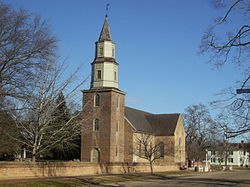Bruton Parish
|
Bruton Parish Church
|
|

Bruton Parish Church from Duke of Gloucester Street
|
|
| Location | Williamsburg, Virginia |
|---|---|
| Coordinates | 37°16′16″N 76°42′10″W / 37.27111°N 76.70278°WCoordinates: 37°16′16″N 76°42′10″W / 37.27111°N 76.70278°W |
| Area | C.H.A. |
| Built | 1677 |
| Architect | Alexander Spotswood |
| Architectural style | Georgian, Other |
| NRHP reference # | 70000861 |
| VLR # | 137-0007 |
| Significant dates | |
| Added to NRHP | May 10, 1970 |
| Designated NHL | April 15, 1970 |
| Designated VLR | September 18, 1973 |
Bruton Parish Church is located in the restored area of Colonial Williamsburg in Williamsburg, Virginia, United States. It was established in 1674 by the consolidation of two previous parishes in the Virginia Colony, and remains an active Episcopal parish. The building, constructed 1711-15, was designated a National Historic Landmark in 1970 as a well-preserved early example of colonial religious architecture.
The roots of Bruton Parish Church trace back to both the Church of England and the new settlement of the Colony of Virginia at Jamestown in the early 17th century. The role of the church and its relationship to the government had been established by King Henry VIII some years earlier. The same relationship was established in the new colony.
When the English colony was established at Jamestown on May 14, 1607, the conduct of worship and the building of a primitive chapel were given priority even as the first fort was built. The Reverend Robert Hunt served as the first chaplain. He had been the chaplain appointed to serve as spiritual leader of the three-ship expedition headed by Christopher Newport, and he lit the candle for the Anglican Church in Virginia a few weeks earlier when he first lifted his voice in public thanksgiving and prayer on April 29, as the settlers made what has come to be known as their "First Landing" near the entrance to the Chesapeake Bay. He also was the one to plant the cross at Cape Henry (which they named after Henry Frederick, Prince of Wales, the eldest son of King James I).
Captain John Smith described the Reverend Mr Hunt as our honest, religious and courageous divine. In his role as religious leader, he was a peacemaker, often bringing harmony to a quarreling group of men. Hunt was among those who did not survive that first year. After five very difficult years, during which the majority of the constant flow of colonists did not survive, the colony began to grow. As in England, the parish became a unit of local importance equal in power and practical aspects to other entities such as the courts and even the House of Burgesses.
...
Wikipedia


